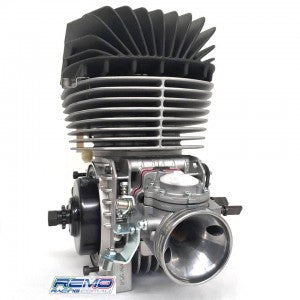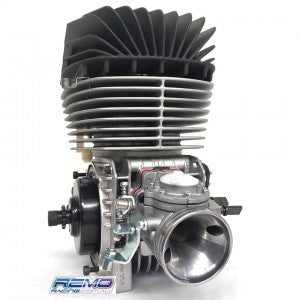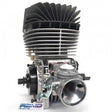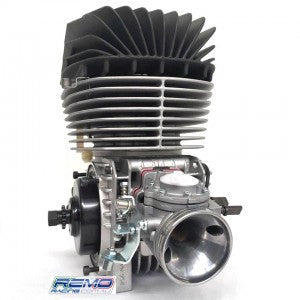IAME KA100 PARILLA REEDJET AUS ENGINE - With factory fitted Roller bearings
Couldn't load pickup availability
For downloads and other information click here
On this page you will also find suggested Carby settings and Operating Procedures.
Technical Details
| Classes | KA4 Junior, KA3 Junior, KA4 Senior, KA3 Senior |
| Engine type | OTTO / 2-stroke air-cooled single cylinder |
| Bore | Ø48.20mm - Ø48.53mm max. |
| Stroke | 54.00mm |
| Displacement | 98.53cc - 100.00cc max. |
| Max. power |
22.0hp @ 10,250rpm (unrestricted 13.0hp @ 9,500rpm (restricted) |
| Max. torque |
15.0Nm @ 9,750rpm (unrestricted) 9.0Nm @ 9,000rpm (restricted) |
| Inlet system | Reed valve in the crankcase |
| Lubrication | Fuel/oil mixture 5% |
| Ignition | Analogue with adjustable advance |
| Starting | On board electric starter |
| Clutch | 3-mass centrifugal dry |
Your KA100 engine comes complete with the following;
- Ignition with H.T. coil
- Reinforced wiring loom with pushbuttons
- Lateral cockpit for pushbuttons
- NGK BR10EG spark plug with resistive cap
- Centrifugal clutch assembly with z11 interchangeable sprocket
- TILLOTSON HW-33A Ø24mm carburettor (expressly designed for this engine)
- Exhaust manifold (inc. exhaust manifold restrictor)
- One-piece exhaust muffler, with integrated silencer
- Inlet silencer (Airbox with filter)
Other features;
- Simple Analogue ignition system.
- Simple cable harness, just for starting and stopping engine, (Engine start possible even without battery, by an external starter).
- Air cooling simplicity, no radiator hoses, no water pumps, no belts makes it easier for the beginner to remove, replace and maintain the engine.
- Extended fins control engine temperature even in very hot climatic conditions.
- Centrifugal clutch assembly with interchangeable sprocket.
- One piece exhaust muffler with integrated silencer.
- Inlet silencer (Airbox with filter)
- Tillotson HW-33A Ø24mm carburettor (expressly designed for the KA100 engine)
- High quality, accurate machining:
- Precise cast iron liner with 5-Axis CNC machined ports.
- High hardness aluminium alloy for cylinder barrel, cylinder head and crankcase.
- Casehardened and grinded steel for crankshaft and conrod, allowing disassembly and re-assembly multiple times.
- Total weight of approx 22kg complete with accessories.
OTHER INFO; The KA100 runs around 90ºC cooler than the engine it replaced due to a very compact combustion chamber which produces less heat in the cylinder and cylinder head. Hi-tech materials combined with a state of the art fin design also aid in reducing operating temperature. Importantly, this means the driver will not have to become an expert “carburettor choker” to maintain engine performance as was the case with previous air-cooled engines, there is also no need to alter the tuning whilst racing”
Suggested Carburettor Settings;
Tillotson HW-33A
Low Jet: 1 Hour (1 turn out)
High Jet: 1 Hour (1 turn out)
KA3 Unrestricted
Low Jet: 1 Hour (1 turn out)
High Jet: 1 Hour & 5 Minutes (1 & 1/8 turns out)
Metering Lever Height
Top of the lever should be dead-level with the Carby body.
Pop-Off Pressure
8-12PSI, a setting of 10PSI is a good starting point.
TIP: A higher pop off pressure will generally require a richer setting on the low jet to give the engine enough fuel off the turn. As a result, due to the efficiency of the low jet circuit, this richer setting will deliver too much fuel in the mid range RPM causing the engine to feel sluggish. Therefore it is recommended to avoid using a very high pop off pressure.
Tillotson HL-398A
KA4 Restricted
Low Jet: 1 hour & 45 minutes (1 & 3/4 turn out)
High Jet: 45 minutes (3/4 turn out)
KA3 Unrestricted
Low Jet: 1 hour & 45 to 55 minutes (Just under 2 turns out)
High Jet: 45 minutes (3/4 turn out)
Idle Screw
Screw in until the engine idles at 2,000 to 2,500 RPM, this makes starting the engine very easy.
Pop-Off Pressure
8 to 10 PSI
Metering Lever Height
Top of the lever should be dead-level with the Carby body.
Suggested Operating Procedures;
Gearing
Gearing can vary greatly depending on circuit layout, grip level, weight and many other factors. Below is a loose guideline to assist in finding the optimal gearing.
KA4 Restricted (19mm)
To work out your appropriate gearing you need to be doing around 13,000 RPM + or - 400 RPM, depending on the circuit layout.
KA3 Unrestricted
To work out your appropriate gearing you need to be doing around 14,500 RPM + or - 400 RPM, depending on the circuit layout.
Oil Ratio
16:1, this is on the safe side as we do not know the quality of oil some customers use or the age of the fuel.
Air Filter
It is essential preventative maintenance to oil the air filter with a good quality filter oil, a normal procedure for any reed valve engine. As is the nature of a reed valve engine the carburettor is mounted on the front of the crankcase leading through to the Crankshaft. A poorly maintained air filter will increase the chance of dirt entering the engine shortening the life of bottom end components.
- A brand new or freshly rebuilt engine has to be run in before going flat out to achieve peak performance and engine life.
It is suggested to run-in for one 30 minute session consisting of 3 x 10 minute segments.
First 10 minutes 6,000 to 9,000 RPM on and off the throttle pedal.
Next 10 minutes up to 12,000 RPM on and off the throttle pedal.
Final 10 minutes up to 14,000 RPM on and off the throttle pedal.
During the final 10 minutes open up the high jet an extra ¼ of a turn and drive it flat out.
Now that you have run-in your KA100 Reedjet engine you can set the high jet back to the normal operating setting.
- Each time you hit the circuit it’s recommend to complete at least 1 warm up lap, as is a normal procedure for any high performance kart engine, before you go flat out down the straight for the fist time.
- By not warming the engine up correctly, you run the risk of cold seizing the first time down the straight as the piston expands at a greater rate than the cylinder wall causing the piston to bore clearance to become tighter than normal.
Exhaust Springs
To prolong the life of the exhaust springs it is good practice to wrap tie wire or a long pedal spring (100mm or so long) around the two exhaust springs to stop them from vibrating.
Spark Plug
Cold Weather: NGK B8EGV
Hot Weather: NGK B9EGV - B10EGV
Your engine comes standard with an NGK 10 heat range plug, this is a conservative plug and may run too cold in some climates to burn the fuel as efficiently as possible, potentially leading to a fouled plug. If this occurs moving to a hotter burning plug (B8-B9) will prevent any issue. Testing has found an NGK B9EGV plug to be the best “all rounder” and will work in most climates.
Operating/Start Procedure - Prior to First Session
- Before putting your kart on the track for the first session you must prime the carburettor with fuel, this will ensure your engine will start first time while avoiding frustration and unnecessary wear on the starter motor.
Screw the spark plug out of the engine and place it on the cylinder head with the plug boot attached, now remove the airbox. Place your hand or hold a rag over the front of the carburettor and press the starter button. This will choke the engine, drawing fuel out of the tank and into the carburettor. Hold your hand against the carby until you feel or see fuel running out the front of the carby. The engine is now primed and you can replace the airbox and spark plug.
Leaving The Grid
When starting the engine to head out for a session it is best to have the throttle pedal cracked slightly open (with foot on the brake), simply press the start button and drive straight out of the grid. It’s not a good idea to sit idling for a long period of time as this can foul the plug.
After leaving the grid, give your KA100 engine a short burst of full throttle, this will help clear any accumulated fuel in the engine.
Preparing for a Race Start
During the formation laps prior to getting a start, it is advisable to drive the roll up laps at a constant speed with your throttle at a cracked open position while applying slight pressure to the brake. This will put the engine under load and burn any excess fuel, reducing the chance of fouling a plug and ensuring the engine will accelerate crisply off the line giving you an excellent start!
As your KA100 engine runs so efficiently in cylinder head temperature, on the roll down laps there is a possibility that you will accumulate un-burnt fuel in the combustion chamber. As a result it may be possible to foul a spark plug when starting the engine prior to your next session. To help prevent this, simply hold your throttle pedal on the cracked open position (around 4000rpm) while applying slight brake pedal pressure (this is called 'riding the brake') before coming to a stop, this will put the engine under load and burn any excess fuel. Alternatively you can depress the kill switch on the way into the in-grid and just roll into your stop position.
Payment & Security
Payment methods
Your payment information is processed securely. We do not store credit card details nor have access to your credit card information.




